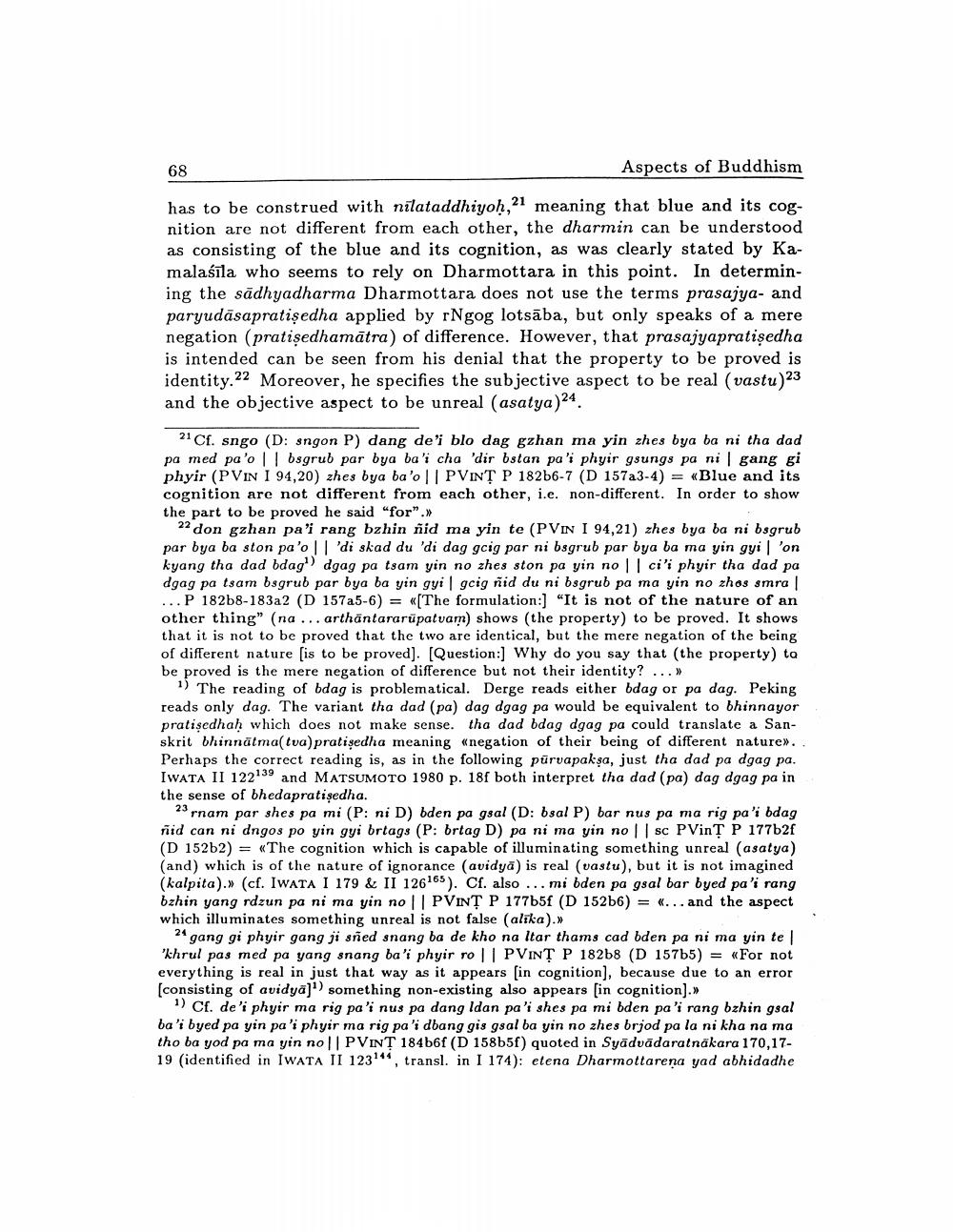Book Title: Rngog Lotsaba On Sahopalambhaniyama Proof In Dharmakirtis Pramanaviniscaya Author(s): Helmut Krasser Publisher: Helmut Krasser View full book textPage 6
________________ 68 Aspects of Buddhism has to be construed with nilataddhiyoḥ,21 meaning that blue and its cognition are not different from each other, the dharmin can be understood as consisting of the blue and its cognition, as was clearly stated by Kamalaśīla who seems to rely on Dharmottara in this point. In determining the sādhyadharma Dharmottara does not use the terms prasajya- and paryudāsapratişedha applied by rNgog lotsāba, but only speaks of a mere negation (pratişedhamātra) of difference. However, that prasajyapratişedha is intended can be seen from his denial that the property to be proved is identity.22 Moreover, he specifies the subjective aspect to be real (vastu)23 and the objective aspect to be unreal (asatya)24. 21 Cf. sngo (D: sngon P) dang de'i blo dag gzhan ma yin zhes bya ba ni tha dad pa med pa'o || bsgrub par bya ba'i cha 'dir bstan pa'i phyir gsungs pa ni l gang gi phyir (P VIN I 94,20) zhes bya ba'o || PVINT P 182b6-7 (D 157a3-4) = «Blue and its cognition are not different from each other, i.e. non-different. In order to show the part to be proved he said "for". 22 don gzhan pa'i rang bzhin nid ma yin te (PVIN I 94,21) zhes bya ba ni bsgrub par bya ba ston pa'o || 'di skad du 'di dag gcig par ni bsgrub par bya ba ma yin gyi l'on kyang tha dad bdag' dgag pa tsam yin no zhes ston pa yin no || ci'i phyir tha dad pa dgag pa tsam bsgrub par bya ba yin gyi gcig ñid du ni bsgrub pa ma yin no zhos smra! ...P 182b8-183a2 (D 157a5-6) = «[The formulation:] "It is not of the nature of an other thing" (na ... arthāntararüpatvam) shows the property) to be proved. It shows that it is not to be proved that the two are identical, but the mere negation of the being of different nature (is to be proved). (Question:] Why do you say that the property) to be proved is the mere negation of difference but not their identity? ... >> 1) The reading of bdag is problematical. Derge reads either bdag or pa dag. Peking reads only dag. The variant tha dad (pa) dag dgag pa would be equivalent to bhinnayor pratisedhaḥ which does not make sense. tha dad bdag dgag pa could translate a Sanskrit bhinnātma(tva) pratisedha meaning «negation of their being of different nature». Perhaps the correct reading is, as in the following pūrvapaksa, just tha dad pa dgag pa. IWATA II 122139 and MATSUMOTO 1980 p. 18f both interpret tha dad (pa) dag dgag pa in the sense of bhedapratişedha. 23 rnam par shes pa mi (P: ni D) bden pa gsal (D: bsal P) bar nus pa ma rig pa'i bdag ñid can ni dngos po yin gyi brtags (P: brtag D) pa ni ma yin no | sc PVinȚ P 177b2f (D 152b2) = «The cognition which is capable of illuminating something unreal (asatya) (and) which is of the nature of ignorance (avidyā) is real (vastu), but it is not imagined (kalpita).» (cf. IWATA I 179 & II 126165). Cf. also ... mi bden pa gsal bar byed pa'i rang bzhin yang rdzun pa ni ma yin no | PVINŢ P 177b5f (D 15266) = «... and the aspect which illuminates something unreal is not false (alika).» 24 gang gi phyir gang ji sñed snang ba de kho na ltar thams cad bden pa ni ma yin te 'khrul pas med pa yang snang ba'i phyir ro | PVINT P 182b8 (D 157b5) = «For not everything is real in just that way as it appears in cognition), because due to an error (consisting of avidya)") something non-existing also appears in cognition). 1) Cf. de'i phyir ma rig pa'i nus pa dang ldan pa'i shes pa mi bden pa'i rang bzhin gsal ba'i byed pa yin pa'i phyir ma rig pa'i dbang gis gsal ba yin no zhes brjod pa la ni kha na ma tho ba yod pa ma yin no|| PVNȚ 184b6f (D 158b5f) quoted in Syādvādarat näkara 170,1719 (identified in IWATA II 123144, transl. in I 174): etena Dharmottareņa yad abhidadhePage Navigation
1 ... 4 5 6 7 8 9 10 11 12 13 14 15 16 17 18 19 20 21 22 23 24 25 26
